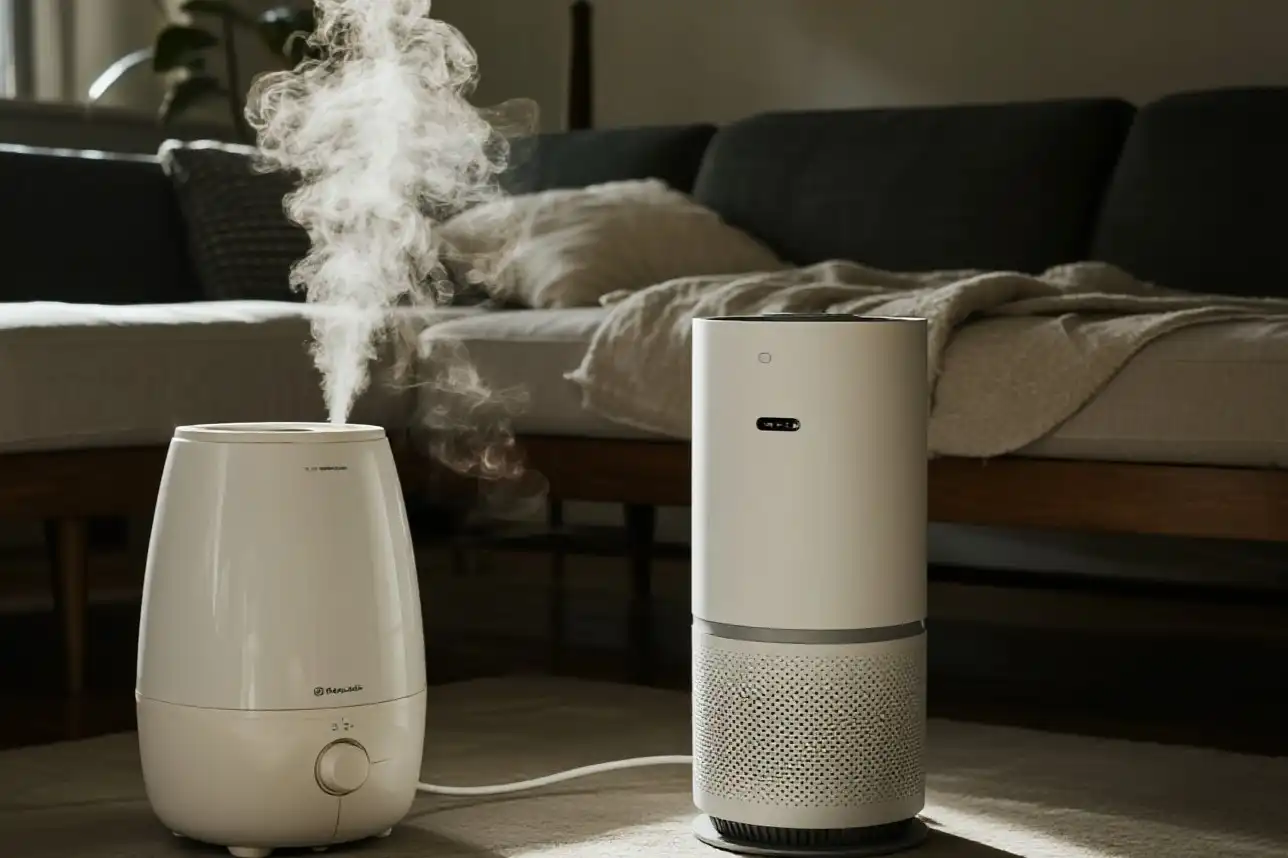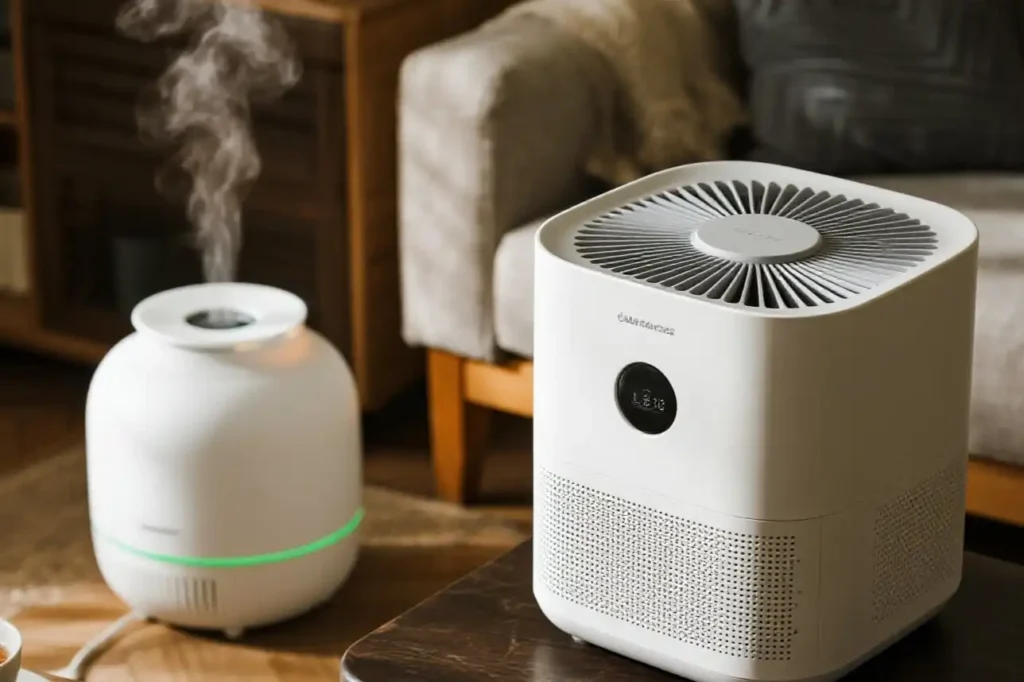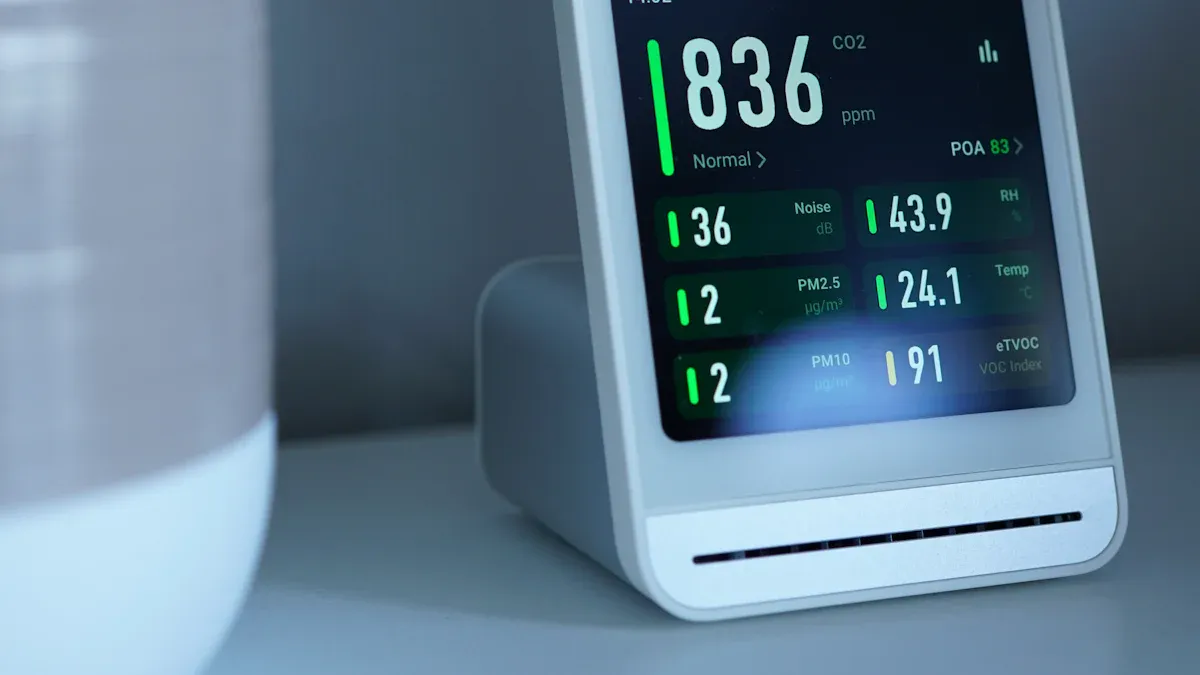
Humidifiers and air purifiers are often used together at home. Sometimes, your air purifier turns off when you use a humidifier. This happens because humidifiers, especially ultrasonic ones, put water and tiny mineral bits in the air. These bits can trick your air purifier’s sensors or fill up its filter. You do not need to worry about this. You can fix this problem with a few easy steps.
Key Takeaways
- Humidifiers put water into dry air. Air purifiers take out dust and allergens. This helps make the air better to breathe.
- If you use tap water in humidifiers, it makes mineral dust. This dust can block air purifier filters. It can also make the purifier turn off.
- Keep your humidifier and air purifier at least 3 feet apart. This stops wet air from confusing the purifier’s sensors.
- Use distilled water in your humidifier. This lowers mineral dust. It helps both machines work well and last longer.
- Clean your humidifier and air purifier often. This stops mold, germs, and dust from building up. It keeps your air clean and fresh.
Humidifiers and Air Purifiers: How They Work

Device Functions
Humidifiers and air purifiers help make your air better. Each one does something different. Humidifiers put water into the air. This is good when your house feels dry. Dry air happens a lot in winter or dry places. Air purifiers take out dust, pollen, smoke, and other small things from the air. If you have allergies or asthma, air purifiers can help you breathe better.
Here is a table that shows what each device does and how it helps you:
| Device | Primary Function | Health Benefits and Usage Notes |
|---|---|---|
| Humidifiers | Add moisture to dry indoor air to relieve dryness-related symptoms like irritated eyes, throat, and skin. | Help with sore throats, coughs, and dry skin. Good for babies and people in dry environments. Keep humidity between 30-50%. |
| Air Purifiers | Remove airborne particles like mold, pollen, dust mites, and smoke using filters. | Help people with allergies or asthma. Make air cleaner by trapping up to 99.9% of particles. Need regular filter changes. |
Tip: Using both humidifiers and air purifiers together can make your air feel better and cleaner.
Interaction Effects
When you use both devices in one room, they can change how each other works. Humidifiers, especially ultrasonic ones, put water drops and tiny minerals in the air. If you use tap water, even more small bits go into the air. These bits are so small they float around for a long time.
- The extra water and bits from humidifiers can:
- Make air purifier sensors think the air is dirty.
- Make the air purifier work harder or turn off.
- Fill up the air purifier’s filter faster.
- Sometimes, the air purifier may sense too much water in the air and shut down to stop problems like mold.
You can help by using distilled water in your humidifier. This puts fewer bits in the air and helps both machines work well. Humidifiers and air purifiers are both important, but you need to know how they affect each other to get the best air.
Why Purifiers Turn Off

Moisture and Sensors
When you use both a humidifier and an air purifier, the extra water in the air can confuse the air purifier’s sensors. Most air purifiers have sensors that look for tiny things floating in the air. These sensors shine a light and see how much bounces back from the particles. When you turn on a humidifier, especially an ultrasonic one, it puts out tiny drops of water and sometimes steam. The sensors can mistake these drops for dust or pollution.
Studies show that when the air is more humid, between 30% and 70%, the sensors start to see water drops as dust. The air purifier thinks the air is dirty, but it is just water. This can make the purifier run faster or even turn off to protect itself. Some sensors, like metal oxide ones, can stop working right because water sticks to them. Over time, this can make the sensor give wrong numbers. If your air purifier has a gas sensor, too much water in the air can make it less accurate.
Note: High humidity can break some sensors or make them stop working. You should check and fix your air purifier’s sensors if you use a humidifier a lot.
Mineral Dust Issues
Ultrasonic humidifiers do not only add water to the air. They also send out tiny mineral bits from the water, especially if you use tap water. Tap water has minerals like calcium and magnesium. When the humidifier turns this water into mist, the minerals become fine dust. This dust is called “white dust” and can land on your furniture and floors. It can also float in the air, where your air purifier tries to catch it.
When your air purifier senses this extra dust, it may think the air is very dirty. The purifier will work harder, and its filter will fill up faster. If the filter gets clogged, the purifier might turn off to avoid damage. The more minerals in your water, the more dust your humidifier will make. Hard water makes the most dust. This dust can also build up inside your humidifier, making it harder to clean and less useful.
Tip: Using distilled water in your humidifier can help stop white dust and keep both your humidifier and air purifier working better.
Filter Overload
Your air purifier uses a filter to catch dust, pollen, and other things. When you use both devices, the filter has to catch normal dust plus extra mineral dust and water drops. This can make the filter fill up much faster than usual. If the filter gets too full, air cannot move through it easily. The purifier may slow down or turn off to stop damage.
Studies show that mineral dust from humidifiers can block filters quickly. A filter that usually lasts two or three months might get blocked in just a few days if there is a lot of white dust. Clogged filters also make it easier for mold and bacteria to grow, especially if the air is very wet. This can make the air purifier work worse and even spread germs.
- What happens when filters get overloaded:
- Airflow drops, so the purifier cannot clean the air well.
- The purifier may turn off to protect its motor.
- You need to change filters more often, which costs more money.
- Mold and bacteria can grow on wet filters.
Dirty humidifiers can also add bacteria and mold to the air. If your humidifier is not clean, it can send germs into the air, and your purifier’s filter will have to catch them. This makes the filter fill up even faster and can cause the purifier to turn off.
Remember: Clean your humidifier and air purifier often. Use distilled water to help your filters last longer and keep your air clean.
Preventing Problems
Placement Tips
You can stop most issues by putting your devices in smart places. Always keep at least 3 feet between your humidifier and air purifier. This gap keeps wet air from going right into the purifier. Put each device on different sides or corners of the room. This helps both machines do their jobs well and keeps the air even. Do not put either device close to windows or doors. Wind from outside can make them work worse. Use a hygrometer to check how wet the air is. Try to keep the humidity between 30% and 50%. Good placement helps you get the best from both devices.
Tip: Putting your machines in the right spots keeps your air clean and comfy.
Water Choice
The kind of water you use in your humidifier is important. Tap water has minerals that turn into white dust. This dust can block your air purifier and fill the air with tiny bits. Use distilled water in your humidifier. Distilled water has almost no minerals in it. Studies show distilled water can lower airborne particles by over 80%. Many makers and health experts say to use distilled water. It keeps your humidifier cleaner and helps your air purifier last longer.
- Benefits of using distilled water:
- Less white dust in your house
- Fewer bits for your air purifier to catch
- Lower chance of mold and germs
Maintenance
Cleaning your devices often keeps them working well. Rinse your humidifier every day to keep it clean. Once a week, clean it deeply with vinegar. Do not use strong cleaners like bleach because they can hurt the machine. For your air purifier, check and change filters as the maker says. Clean the outside and grills with a vacuum or cloth. Make sure both machines have space around them for air to move. Keeping both machines clean stops mold, germs, and dust from building up. This helps stop problems and keeps your air healthy.
Note: Clean machines last longer and work better together.
Best Practices for Humidifiers and Air Purifiers
Daily Use
You can keep your air clean by doing easy daily tasks. Check your humidifier and air purifier every morning. Make sure they are not dirty and do not have mold. After you use your humidifier, pour out any water left inside. Wipe the container dry with a towel. Leave the lid off so it can dry in the air. This stops mold and germs from growing. Always use distilled or filtered water in your humidifier. This helps stop white dust and keeps minerals from building up.
Here are some daily habits to help you use your machines safely:
- Pour out and dry the humidifier after each use.
- Keep the humidifier open so it dries in the air.
- Put in new water every day.
- Clean both machines often, at least every few days.
- Change filters when the maker says to.
- Do not add oils or other things unless the manual says it is okay.
- Put humidifiers in open spots, not in tight spaces.
Tip: Clean machines work better and last longer.
Monitoring Air Quality
You can use special tools to check the air and humidity in your home. Devices like Aranet4 HOME, Qingping Pro, and PurpleAir Zen show you numbers for CO2, dust, and humidity. These monitors have sensors that check for tiny bits and water in the air. Good monitors help you know when to use your humidifier or air purifier.
| Device Name | What It Measures | Why Use It? |
|---|---|---|
| Aranet4 HOME | CO2, humidity, temp | Checks if air is fresh and comfy |
| Qingping Pro | Dust, CO2, humidity | Watches many air quality things |
| PurpleAir Zen | Dust, gases, humidity | Very good for dust and gases |
Smart air monitors can tell you if the air or humidity is too high. You can then change your humidifier or air purifier settings. Some smart tools can even change fan speeds or turn on by themselves. Try to keep your home’s humidity between 30% and 50%. This helps stop mold and keeps the air nice.
Note: Checking air quality often helps you use humidifiers and air purifiers better.
Humidifiers and air purifiers help make your air better if you use them right. Sometimes, your air purifier might turn off if the humidifier puts too much water or mineral dust in the air. You can stop this by using distilled water, keeping the machines apart, and cleaning them often. Experts say these steps help stop filters from getting blocked and sensors from making mistakes. When you do these things, your home will be safer and healthier for your family.
Remember: Good habits keep your air fresh and your devices working well.
FAQ
What happens if you use tap water in your humidifier?
Tap water adds minerals to the air. These minerals become white dust. Your air purifier will catch this dust. The filter fills up faster. You may need to change filters more often.
Tip: Use distilled water to avoid white dust.
What is the best distance between a humidifier and an air purifier?
You should keep at least 3 feet between your humidifier and air purifier. This space helps both devices work well. It stops wet air from going straight into the purifier.
What should you do if your air purifier keeps turning off?
Check the filter first. It may be full. Clean your humidifier and use distilled water. Move the devices farther apart. If the problem continues, check the air purifier’s manual for help.
What is white dust from a humidifier?
White dust is made of minerals from tap water. Ultrasonic humidifiers create this dust. It settles on furniture and can clog your air purifier’s filter.
What can you do to make both devices last longer?
Clean both machines often. Use distilled water in your humidifier. Change air purifier filters as needed. Place the devices apart. These steps help your devices work better and last longer.
See also
Can humidifiers and air purifiers be used simultaneously?
Air Sanitizer or Air Purifier What’s the Right Choice for You in 2025
The benefits of air purifiers for illness prevention and health improvement
Things to Consider Before Buying an AQI Sensor Air Purifier with Display
